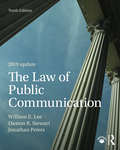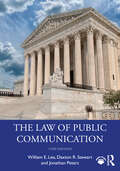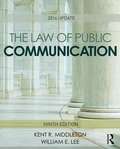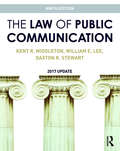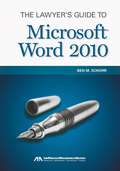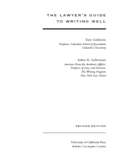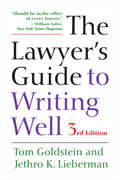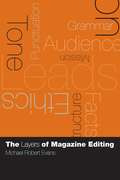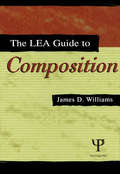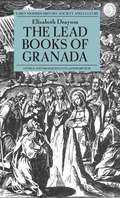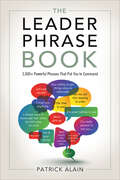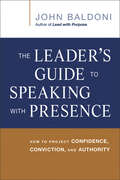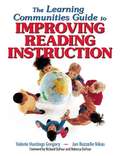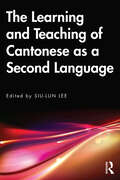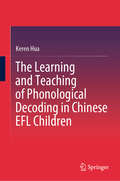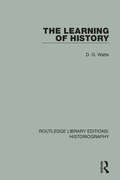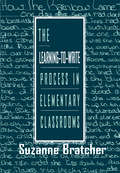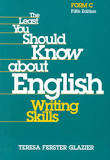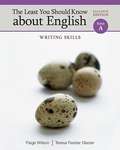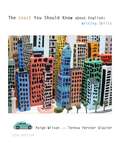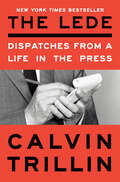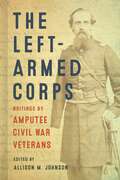- Table View
- List View
The Law of Public Communication
by William E. Lee Kent R. Middleton Daxton R. StewartNow in its tenth edition, The Law of Public Communication provides an overview of media law that includes the most current legal developments. It explains the laws affecting the daily work of writers, broadcasters, PR practitioners, photographers, and other public communicators. By providing statutes and cases in an accessible manner, even to students studying law for the first time, the authors ensure that students will acquire a firm grasp of the legal issues affecting the media. This new edition features color photos, as well as breakout boxes that apply the book’s principles to daily life. The new case studies discussed often reflect new technologies and professional practices.
The Law of Public Communication
by William E. Lee Daxton R. Stewart Jonathan PetersThis thoroughly updated classic textbook provides an overview of communication and media law, including the most current legal developments. It explains laws affecting the daily work of writers, broadcasters, public relations practitioners, photographers, bloggers and other public communicators.By outlining statutes and cases in an accessible manner, even to students studying law for the first time, the authors ensure that readers acquire a firm grasp of the legal issues affecting the media. The book examines legal topics such as libel, privacy, intellectual property, obscenity and access to information, considering the development and current standing of relevant laws and important cases. It examines how these laws affect public, political and commercial communication. The 13th edition covers contemporary U.S. Supreme Court cases, including the true threats case Counterman v. Colorado, the Andy Warhol fair use case and the Jack Daniel's trademark parody case. It also presents the Biden administration's revision of policy on the use of subpoenas and search warrants to uncover reporters' confidential sources along with the gag orders imposed by courts handling criminal and civil trials in which Donald Trump is a defendant. Further cases explored include the attacks by legislatures against the LGBTQ community, exemplified by a Tennessee law banning drag performances, and the emerging issues presented by artificial intelligence and the content moderation policies of social media platforms.The Law of Public Communication is an ideal core textbook for undergraduate and graduate courses in communication law and mass media law.A test bank for instructors is available at www.routledge.com/9781032676388
The Law of Public Communication: 2016 Update
by William E. Lee Daxton Stewart Kent R. MiddletonThe Law of Public Communication provides an overview of media law that includes the most current legal developments today. It explains the laws affecting the daily work of writers, broadcasters, advertisers, cable operators, Internet service providers, public relations practitioners, photographers, bloggers, and other public communicators. Authors Kent R. Middleton, William E. Lee, and Daxton R. Stewart take students through the basic legal principles and methods of analysis that allow students to study and keep abreast of the rapidly changing field of public communication. By providing statutes and cases in a cohesive manner that is understandable, even to students studying law for the first time, the authors ensure that students will acquire a firm grasp of the legal issues affecting the media. This 2017 Update brings the Ninth Edition up to date with the most recent cases and examples affecting media professionals and public communicators.
The Law of Public Communication: 2017 Update
by William E. Lee Daxton Stewart Kent R. MiddletonThe Law of Public Communication provides an overview of media law that includes the most current legal developments today. It explains the laws affecting the daily work of writers, broadcasters, advertisers, cable operators, Internet service providers, public relations practitioners, photographers, bloggers, and other public communicators. Authors Kent R. Middleton, William E. Lee, and Daxton R. Stewart take students through the basic legal principles and methods of analysis that allow students to study and keep abreast of the rapidly changing field of public communication. By providing statutes and cases in a cohesive manner that is understandable, even to students studying law for the first time, the authors ensure that students will acquire a firm grasp of the legal issues affecting the media. This 2017 Update brings the Ninth Edition up to date with the most recent cases and examples affecting media professionals and public communicators.
The Lawyer's Essential Guide to Writing: Proven Tools and Techniques
by Marie BuckleyThe Lawyer's Essential Guide to Writing is a readable, concrete guide to contemporary legal writing. Based on Marie Buckley's years of experience coaching lawyers, this book provides a systematic approach to all forms of written communication, from memoranda and briefs to e-mail and blogs. The book sets forth three principles for powerful writing and shows how to apply those principles to develop a clean and confident style.
The Lawyer's Guide to Microsoft® Word 2010
by Ben M. SchorrThis handy reference includes clear explanations, legal-specific descriptions, and time-saving tips for getting the most out of Microsoft Word®--and customizing it for the needs of today's legal professional. Focusing on the tools and features that are essential for lawyers in their everyday practice, The Lawyer's Guide to Microsoft® Word 2010 explains in detail the key components to help make you more effective, more efficient, and more successful.
The Lawyer's Guide to Writing Well
by Tom Goldstein Jethro K. LiebermanThis eminently practical volume demystifies legal writing, outlines the causes and consequences of bad writing, and prescribes straightforward, easy-to-apply remedies that will make your writing readable. Complete with usage notes that address lawyers' most common errors, this well-organized book is both an invaluable tool for practicing lawyers and a sensible grounding for law students. This much-revised second edition contains a set of editing exercises (and a suggested revision key with explanations) to test your skill. This book is a definitive guide to becoming a better writer--and a better lawyer.
The Lawyer's Guide to Writing Well
by Tom Goldstein Jethro K. LiebermanThis eminently practical volume demystifies legal writing, outlines the causes and consequences of bad writing, and prescribes straightforward, easy-to-apply remedies that will make your writing readable. Complete with usage notes that address lawyers' most common errors, this well-organized book is both an invaluable tool for practicing lawyers and a sensible grounding for law students. This much-revised second edition contains a set of editing exercises (and a suggested revision key with explanations) to test your skill. This book is a definitive guide to becoming a better writer--and a better lawyer.
The Layers of Magazine Editing
by Michael Robert EvansUnlike the myriad writing manuals that emphasize grammar, sentence structure, and other skills necessary for entry-level editing jobs, this engaging book adopts a broader view, beginning with the larger topics of audience, mission, and tone, and working its way down, layer by layer, to the smaller questions of grammar and punctuation. Based on Michael Evans's years of experience as an editor and supplemented by invaluable observations from the editors of more than sixty magazines—including The Atlantic, Better Homes and Gardens, Ebony, Esquire, and National Geographic—this book reveals the people-oriented nature of the job.
The Lea Guide To Composition
by James D. WilliamsBasic text for freshman composition courses. Draws on the most significant theory, strategy, and techniques in composition studies. Emphasizes writing as a vehicle for learning.
The Lead Books of Granada
by Elizabeth DraysonHailed as early Christian texts as important as the Dead Sea Scrolls, yet condemned by the Vatican as Islamic heresies, the Lead books of Granada, written on discs of lead and unearthed on a Granadan hillside, weave a mysterious tale of duplicity and daring set in the religious crucible of sixteenth-century Spain. This book evaluates the cultural status and importance of these polyvalent, ambiguous artefacts which embody many of the dualities and paradoxes inherent in the racial and religious dilemmas of Early Modern Spain. Using the words of key individuals, and set against the background of conflict between Spanish Christians and Moriscos in the late fifteen-hundreds, The Lead Books of Granada tells a story of resilient resistance and creative ingenuity in the face of impossibly powerful negative forces, a resistance embodied by a small group of courageous, idealistic men who lived a double life in Granada just before the expulsion of the Moriscos.
The Leader Phrase Book: 3,000+ Powerful Phrases That Put You In Command
by Patrick AlainEasily find the right words to respond like a leader in any situation, communicate effectively, and make your way to success.The Leader Phrase Book contains more than 3,000 dynamic phrases that will enable you to prevail in virtually all of life’s important situations. You will be in command of your words and always stay ahead of the game. With this passport to success, you will begin a new journey on which you are among the charismatic, the untouchable . . . the elite.This easy-to-use reference book will give you a new image you can take pride in helping you to quickly reach your full leadership potential. You will have all the weapons to effectively succeed whenever vibrant, forceful language is required. It works like magic!The Leader Phrase Book will teach you how to:• Speak like a leader• Master all conversations• Attain a charismatic presence• Gain the respect of others• Achieve a lightning-fast rhetoric• Find the right phrases instantly• Argue effectively• Be the envy of all you meetThe Leader Phrase Book is the culmination of ten years of Patrick’s personal research on how leaders communicate. It is the summation of his efforts to share one of the most invaluable skills in life: “how to put yourself in command.”Praise for The Leader Phrase Book“This refreshing and practical tool will help to enlarge, promote, and articulate the world of communication.” —Cristina Roggero, Pepperdine University professor of literature“An indispensable tool to help you become quickly fluent in phrases that put you ahead in the marketplace.” —Tony Azar, Homeland Security Chief Engineer“A must read for anyone who wants to move ahead in business.” —Jami Levesque, technical director of 300 and Transformers 3
The Leader's Guide to Speaking with Presence: How to Project Confidence, Conviction, and Authority
by John BaldoniWhether in a meeting or a presentation, a watercooler conversation or a formal speech, a leader&’s most important job is to.Your idea may be groundbreaking. The potential profits might be exhilarating. The time to act may be right now, but if you&’re not able to craft and deliver a clear message that doesn&’t lead the audience to gain your perspective, that can be the difference between your pitch being transformational and becoming forgettable.Executive coach and leadership expert John Baldoni provides this concise tool kit containing more than 100 practical tips for creating and communicating meaningful messages with presence and authority.In The Leader's Guide to Speaking with Presence, you will discover how to:Present their ideas clearly and provide contextRadiate confidence and put the audience at easeRefine their deliveryUse stories to inform, involve, and inspireLeverage the energy of any roomConvey optimism tempered with reality to gain buy-inTurn PowerPoint presentations into performancesWhen a leader learns to own the room with an authentic and persuasive speech, the audience will become putty in their hands. The Leader's Guide to Speaking with Presence helps leaders achieve the kind of genuine presence that evolves into lasting trust and quantifiable influence.
The Learning Communities Guide to Improving Reading Instruction
by Valerie Hastings Gregory Jan Rozzelle NikasThe themes of attending to individual needs, providing assessment-driven instruction, and creating long-term, focused professional development plans are solid and consistent throughout.
The Learning and Teaching of Cantonese as a Second Language
by Siu-Lun LeeThe Learning and Teaching of Cantonese as a Second Language brings together contributions on such issues as Cantonese textbooks, linguistic description, literacy and tone acquisition, supplemented by case studies from the Netherlands and Japan. The learning and teaching of Cantonese as a second language is a subject of considerable interest in the international academic community, and the first international symposium on teaching Cantonese as a second language, held at the Chinese University of Hong Kong in October 2019, brought together leading researchers in this field. This conference provided the inspiration for the current volume, The Learning and Teaching of Cantonese as a Second Language. In the Hong Kong context, historically, the term ‘Cantonese’ refers to the language varieties of immigrants who came to the territory from various areas in Guangdong province, including Macau, Panyu, Taishan, Xinhui and Zhongshan. From the late nineteenth century onwards, their speech coalesced into the contemporary variety of Cantonese used in Hong Kong today. The term ‘Cantonese’ is also used to refer to the entire Yue subgroup of Chinese, which includes varieties of Cantonese spoken in southern China, Hong Kong, Macau, Malaysia, Singapore and among overseas Chinese in Australia, Europe and North America. In all, it is estimated that there are about 70 million Cantonese speakers in the world. This volume is of direct relevance to educators, language teachers, linguists and all those concerned with the learning of Cantonese as a second language.
The Learning and Teaching of Phonological Decoding in Chinese EFL Children
by Keren HuaThis book presents the learning and teaching of phonological decoding in Chinese EFL primary classrooms. The phonological decoding ability of the children is described, interpreted, and evaluated, the teaching materials are analyzed and the classroom instruction observed, and the links between these various facets are explored using both quantitative and qualitative techniques (textbook analysis, classroom observations, interviews with teachers and a textbook writer, reading test and nonword reading test). This book provides insights into Chinese children’s phonological decoding profile, including performance in decoding different types of orthographic units, the strategies children at different levels of reading ability use to sound out vowel graphemes, and their decoding ability in relation to reading ability. The investigation of the teaching practices reveals how the decoding instruction is designed, developed, and delivered to the children and thereby informs the interplay between the classroom instruction and children’s development of phonological decoding skills.
The Learning of History (Routledge Library Editions: Historiography)
by D. G. WattsOriginally published in 1972, this book is a systematic analysis of the objectives and methods of history teaching. The book considers the criticisms of the 1960s and 70s of history as a subject and the pressures for its replacement in the school curriculum. It examines the complex psychological background of learning history and suggests that historical understanding makes an important contribution to cognitive growth. It also stresses the important part played by historical material in the emotional and imaginative life of the child. Concluding with a discussion of practical classroom methods, the author proposes objectives and characteristic concepts of the subject which may be embodied in all levels of teaching.
The Learning-to-write Process in Elementary Classrooms
by Suzanne BratcherThis text models for teachers how to help children learn and write by establishing comfort with writing, building confidence, and developing competence. Several themes run through the learning-to-write-process presented in this text:* Writing is communication;* Writing is a powerful tool for learning;* How children feel about their writing and themselves as writers affects how they learn to write;* Teachers are coworkers with students; children from many backgrounds can learn to write together. The text sythesizes what we know about how children learn, how we write, and what we write into a process of teaching children to write. It is intended to serve as a starting place for developing theories of how to best teach writing.
The Least You Should Know About English: Basic Writing Skills (Form C)
by Teresa Ferster GlazierBasic English writing skills for students.
The Least You Should Know About English: Writing Skills, Form A
by Teresa Ferster Glazier Paige WilsonQuickly master English writing skills with THE LEAST YOU SHOULD KNOW ABOUT ENGLISH: WRITING SKILLS, FORM A, Eleventh Edition. Brief and uncomplicated, this text has helped students learn the basics of English writing for over thirty years with its clear, concise concept explanations and useful, relevant corresponding exercises. Topics include spelling, word choice, sentence structure, punctuation, paragraph and essay writing--as well as more advanced skills such as argumentation and quotation. Check your work easily with exercise answers located in the back of the book, making it an excellent writing resource even after the course has ended.
The Least You Should Know About English: Writing Skills, Form B
by Teresa Ferster Glazier Paige WilsonQuickly master English writing skills with THE LEAST YOU SHOULD KNOW ABOUT ENGLISH: WRITING SKILLS, FORM B, Eleventh Edition. Brief and uncomplicated, this text has helped students learn the basics of English writing for over thirty years with its clear, concise concept explanations and useful, relevant corresponding exercises. Topics include spelling, word choice, sentence structure, punctuation, paragraph and essay writing--as well as more advanced skills such as argumentation and quotation. Check your work easily with exercise answers located in the back of the book, making it an excellent writing resource even after the course has ended.
The Least You Should Know about English: Writing Skills, Twelfth Edition
by Teresa Ferster Glazier Paige WilsonQuickly master English writing skills with THE LEAST YOU SHOULD KNOW ABOUT ENGLISH: WRITING SKILLS, Twelfth Edition. Brief and uncomplicated, this text has helped students learn the basics of English writing for more than 30 years with its clear, concise concept explanations and useful, relevant corresponding exercises. Topics include spelling, word choice, sentence structure, punctuation, paragraph, and essay writing-as well as more advanced skills such as argumentation and quotation. Check your work easily with exercise answers located in the back of the book, making it an excellent writing resource even after the course has ended.
The Lede: Dispatches from a Life in the Press
by Calvin TrillinNEW YORK TIMES BESTSELLER • A fascinating portrait of journalism and the people who make it, told through pieces collected from the incomparable six-decade career of bestselling author and longtime New Yorker writer Calvin Trillin&“The Lede contains profiles . . . that are acknowledged classics of the form and will be studied until A.I. makes hash out of all of us.&”—Dwight Garner, The New York TimesI&’ve been writing about the press almost as long as I&’ve been in the game. At some point, it occurred to me that disparate pieces from various places in various styles amounted to a picture from multiple angles of what the press has been like over the years since I became a practitioner and an observer.Calvin Trillin has reported serious pieces across America for The New Yorker, covered the civil rights movement in the South for Time, and written comic verse for The Nation. But one of his favorite subjects over the years—a superb fit for his unique combination of reportage and humor—has been his own professional environment: the American press.In The Lede, Trillin gathers his incisive, often hilarious writing on reporting, reporters, and their world. There are pieces on a legendary crime reporter in Miami and on an erudite film critic in Dallas who once a week transformed himself from a connoisseur of the French nouvelle vague into a fan of movies like Mother Riley Meets the Vampire. Trillin writes about the paucity of gossip columns in Russia, the icebreaker he'd use if he met one of his subjects socially (e.g.: &“You must be wondering why I referred to you in Time as a dork robot&”), and the origins of a publication called Beautiful Spot: A Magazine of Parking.Uniting all of this is Trillin&’s signature combination of empathy, humor, and graceful prose. The Lede is an invaluable portrait of one our fundamental American institutions from a master journalist.
The Left-Armed Corps: Writings by Amputee Civil War Veterans
by Allison M. JohnsonThe Left-Armed Corps collects and annotates a unique and little-known body of Civil War literature: narrative sketches, accounts, and poetry by veterans who lost the use of their right arms due to wounds sustained during the conflict and who later competed in left-handed penmanship contests in 1865 and 1866. Organized by William Oland Bourne, the contests called on men who lost limbs while fighting for the Union to submit “specimens” of their best left-handed “business” writing in the form of personal statements. Bourne hoped the contests would help veterans reenter the work force and become economically viable citizens. Following Bourne’s aims, the contests commemorated the sacrifices made by veterans and created an archive of individual stories detailing the recently ended conflict. However, the contestants and their entries also present visible evidence—in the form of surprisingly elegant or understandably sloppy handwriting specimens—of the difficulties veterans faced in adapting to life after the war and recovering from its traumas. Their written accounts relate the chaos of the battlefield, the agony of amputation, and the highs and lows of recovery. Editor Allison M. Johnson organizes the selections thematically in order to highlight issues crucial to the experiences of Civil War soldiers, veterans, and amputees, offering invaluable insights into the ways in which former fighting men understood and commemorated their service and sacrifice. A detailed introduction provides background information on the contests and comments on the literary and historical significance of the veterans and their writings. Chapter subjects include political and philosophical treatises by veterans, amateur but poignant poetic testaments, and graphic accounts of wounding and amputation. The Left-Armed Corps makes accessible this archive of powerful testimony and creative expression from Americans who fought to preserve the Union and end slavery.
The Legacies of Modernism
by David JamesAn engagement with the continued importance of modernism is vital for building a nuanced account of the development of the novel after 1945. Bringing together internationally distinguished scholars of twentieth- and twenty-first-century literature, these essays reveal how the most innovative writers working today draw on the legacies of modernist literature. Dynamics of influence and adaptation are traced in dialogues between authors from across the twentieth century: Lawrence and A. S. Byatt, Woolf and J. M. Coetzee, Forster and Zadie Smith. The book sets out new critical and disciplinary foundations for rethinking the very terms we use to map the novel's progression and renewal, enhancing our understanding not only of what modernism was but also what it might still become. With its global reach, The Legacies of Modernism will appeal to scholars working not only in the new modernist studies, but also in postcolonial studies and comparative literature.
